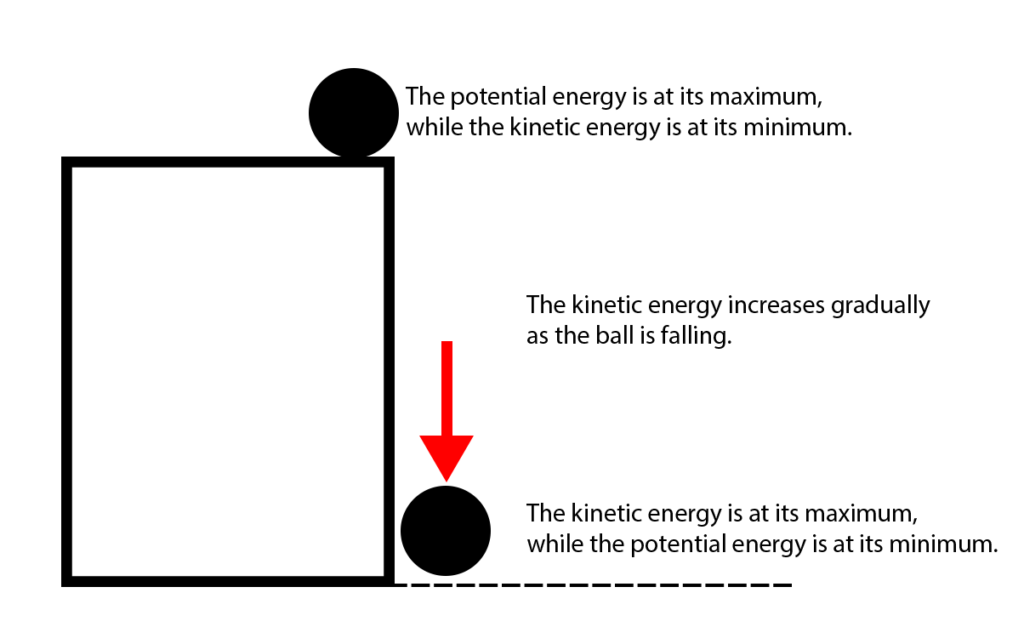What is kinetic energy?
Kinetic energy is the energy a body possesses while it is in motion. The official SI unit for it is a joule (J). However, in the UK, the foot-pound is used more often. Since a body gains kinetic energy while accelerating, it won’t change until the velocity does.
Kinetic energy formula
The formula for calculating kinetic energy is:
E_{k}= \frac {m*v^{2}}{2}m is the mass of the body while v is the velocity.
We can also define it as the amount of work (W) needed in order for the body to reach its velocity from a standstill.
Kinetic energy units
As we said, the official SI unit for kinetic energy is 1J (Joule):
1J = 1 kg \frac {m^2}{s^2}While in the UK, the standard unit is the foot-pound.
Energy
Energy comes in many forms. However, we can categorize them all into two categories: kinetic and potential.
Kinetic energy is transferable and transformable. As an example, let’s take pool. In pool, the player uses a cue to hit the cue ball which will hit another ball, or one of the cushions.
The player uses chemical energy to move the cue. Now, the cue has energy. Once the cue strikes the cue ball, the cue ball starts moving. At that point, the cue ball gains kinetic energy. If it strikes another ball, it will slow down. The ball that it struck will start moving. The cue ball has transferred its energy to the ball it collided with.

This type of collision is elastic collision. Essentially, it means the sum of the kinetic energies of the two balls remains the same after the collision. The other type of collision is inelastic. In inelastic collisions, instead of the kinetic energy being transferred to another object, it is transformed. This transformation can be to heat, sound or even binding energy.
Kinetic vs potential energy
If we take a baseball ball and throw it into the air, it will gradually decelerate before it starts falling down. As it is decelerating (a=-9.80655 m/s2), its kinetic energy is dropping. For a moment, at its peak height, it is completely stationary. At this point, it only has potential energy.
E_{p}= m*g*hm is the mass of the ball. g is the gravitational acceleration and h is the height of the ball (its distance from the ground).
Once the ball starts falling back down, it once again has kinetic energy. However, this time it is rising, because the ball’s velocity is increasing. Its highest kinetic energy will be achieved right before it’s collision with the ground.

With an arrow, it works differently. As you pull the string back and then release it, the arrow starts moving. The potential energy has been converted into kinetic energy. Usually, an arrow shot out of a bow will have about 76J (56 ft-lbs) of energy. Once it hits the ground however, it will do significantly more damage than the rock or the ball.
Kinetic energy examples
We encounter kinetic energy every day. As we said, any object in motion has kinetic energy. If you move your hand, it has kinetic energy. However, as we mentioned previously, kinetic energy is transformable and transferable. As an example of this, we have hydropower plants.
Hydropower plants take advantage of water, that spins a turbine. Once the turbine is spinning, it has kinetic energy. Then, that kinetic energy is converted into electrical energy that you can use in your home or workplace. In order to help you, we have this Energy Conversion tool as well.

Kinetic projectiles
A kinetic projectile is any projectile that does not contain any kind of payload (such as an explosive device). This can be anything from a rock, ball, arrow and even a bullet. However, these three gain their kinetic energy in different ways.
The rock, for instance, usually gains it when it is thrown, or kicked. At that point, as we mentioned earlier, chemical energy has been converted into kinetic. However, once the rock hits the ground it will do work. In fact, it will do exactly as much work, as it had kinetic energy right before it hit the ground. Mathematically:
E_{k} (pre-collision) = WA bullet gets shot out of the muzzle of a firearm at a very high velocity. We call this muzzle energy. Most of the time, muzzle energy is the indicator of how much damage a firearm can do. However, the type of ammunition is also important. For example, a .357 magnum handgun using a 180-grain bullet (12 g) will produce 790J (580 foot-pound force) of muzzle energy. That same handgun, using a 110-grain bullet (7.1 g) will produce 540J (400 foot-pound force) of energy. This makes sense, considering it depends on mass, as well as velocity.
How to calculate kinetic energy
Now, let’s do a little example. Let’s assume a car that weighs 2000 kg (2 tons, or 4409.245 lbs) is going at a speed of 20 m/s (72 km/h or about 44.7 mph). At that point, its kinetic energy will be:
E_{k}= \frac {2000kg*(20 \frac {m}{s})^{2}}{2} = 800000 J = 800 kJNow let’s do something a little bit more complex. This time, let’s assume an object that weighs 10 kg is free-falling in a vacuum. In these circumstances, we can use a very simple formula for velocity:
v= g*tWhere g is the gravitational acceleration, and t is the time the object has been falling for.
With this in mind, after 5 seconds, the object’s kinetic energy will be:
E_{k}= \frac {10kg * (9.80665 \frac {m}{s^{2}}*5s)^{2}}{2}= \frac {10kg*2404.26\frac {m^{2}}{s^{2}}}{2}=12021.3 J= 12.0213 kJHow to calculate kinetic energy without velocity?
Depending on the task at hand, there are several different ways. For example, if you’re calculating the kinetic energy of an object that started free falling, you can just assume the mechanical energy has been preserved. With this in mind, the kinetic energy will be equal to the potential energy the object had while it was still in the air.
How to calculate average kinetic energy?
To calculate the average kinetic energy of multiple given objects, all you need to do is calculate their arithmetic mean.
How to calculate rotational kinetic energy?
The formula for calculating rotational kinetic energy is:
E_{k-r} = \frac {I \cdot \omega^2}{2}where ω is the angular velocity and I is the moment of inertia around the axis of rotation.
How to calculate velocity from kinetic energy?
All we have to do is reverse-engineer the formula from before:
v^2 = \frac {2 \cdot E_k}{m}How to calculate kinetic energy after collision?
As we said, if the collision is perfectly elastic, no kinetic energy will be lost between the two objects that collided. If the collision is inelastic, kinetic energy will be lost, although it is difficult to tell how much.
FAQ
What is the difference between kinetic and potential energy?
Kinetic energy is the energy of an object in motion, while potential energy is the energy of an object that is not in motion.
Is thermal energy potential or kinetic?
Thermal energy can be both potential and kinetic.
Is chemical energy potential or kinetic?
Chemical energy is a type of potential energy.
Is nuclear energy potential or kinetic?
Nuclear energy is also a type of potential energy.
Is electrical energy potential or kinetic?
Electrical energy is potential until some force is applied to it.
Is mechanical energy potential or kinetic?
Mechanical energy is the energy of a given object. It can be kinetic and potential.
Is sound energy potential or kinetic?
While it can be both, we primarily experience it in its kinetic form.
What does kinetic energy depend on?
Kinetic energy depends on the mass and the velocity of a given object.
What is the unit for kinetic energy?
The official SI unit for kinetic energy is 1J (Joule).
